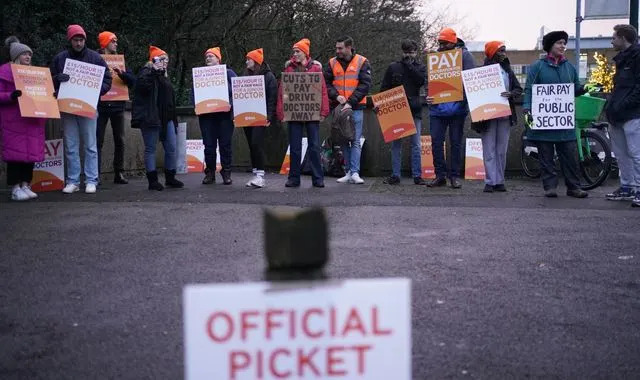French farmers take tractors back on the streets of Paris in new protest
23 February 2024, 18:54

The farmers are part of a broader protest movement in Europe against EU agriculture policies, bureaucracy and overall business conditions.
Angry farmers have headed back to Paris on their tractors in a new protest demanding more government support and simpler regulations, on the eve of a major agricultural fair in the French capital.
Dozens of tractors drove peacefully into Paris carrying flags from Rural Co-ordination, the farmers’ union that staged the protest.
The protesters then posed with their tractors on a bridge over the River Seine with the Eiffel Tower in the background, before heading towards the Vauban plaza in central Paris, where they all gathered for the demonstration.
The latest protest comes three weeks after farmers lifted roadblocks around Paris and elsewhere in the country after the government offered more than 400 million euros to address their grievances over low earnings, heavy regulation and what they describe as unfair competition from abroad.

“Save our agriculture,” the Rural Co-ordination said on X, formerly Twitter. One tractor was carrying a poster reading: “Death is in the field.”
The convoy temporarily slowed traffic on the A4 motorway, east of the capital, and on the Paris ring-road earlier on Friday morning.
French farmers’ actions are part of a broader protest movement in Europe against EU agriculture policies, bureaucracy and overall business conditions.
Farmers complain that the 27-nation bloc’s environmental policies, such as the Green Deal, which calls for limits on the use of chemicals and on greenhouse gas emissions, limit their business and make their products more expensive than non-EU imports.
Other protests are being staged across France as farmers seek to put pressure on the government to implement its promises.
Government officials have held a series of meetings with farmers’ unions in recent weeks to discuss a new bill meant to defend France’s “agricultural sovereignty”, and which will be debated in parliament this spring.

The government’s plan also includes hundreds of millions of euros in aid, tax breaks and a promise not to ban pesticides in France that are allowed elsewhere in Europe. French farmers say such bans put them at an unfair disadvantage.
Cyril Hoffman, a cereal producer in the Burgundy region and a member of the Rural Co-ordination, said farmers now want the government to “take action”.
He said his union is advocating for exempting the farming industry from free trade agreements.
“They can make free trade agreements but agriculture should not be part of them, so we can remain sovereign regarding our food,” Mr Hoffman said. “Only in France do we let our farming disappear.”
French President Emmanuel Macron planned to visit the Paris Agricultural Fair on Saturday, though his office appeared to have removed from his agenda a previously scheduled “big debate” with farmers and members of environmental groups at the event.
The president will meet with farmers’ unions before the fair’s opening, his office said on Friday.
Yet France’s major farmers’ union, the FNSEA, said its board decided not to participate in the debate because “conditions for a peaceful dialogue are not met”. The FNSEA staged another protest in Paris, near the site of the fair, on Friday afternoon.
The Paris Agricultural Fair is one of the world’s largest farm fairs, drawing crowds every year.
By AFP
February 23, 2024

Tractors rolled into Paris on Friday as farmers sought to pile pressure on French President Emmanuel Macron - Copyright NASA/AFP Handout
French and Polish farmers led a new surge of agricultural anger in Europe on Friday, taking tractors into major cities and blocking roads to demand lighter regulation and taxation.
Farmers across the continent have been protesting for weeks over what they say are excessively restrictive environmental rules, competition from cheap imports from outside the European Union and low incomes.
Tractors rolled into Paris as farmers sought to pile pressure on French President Emmanuel Macron on the eve of a flagship annual agricultural show which has turned into a major political event.
Promises of reforms by the government in response to January’s protests have failed to placate the farmers, who were due to discuss their grievances with Macron at the Salon de l’Agriculture on Saturday before the president cancelled the planned debate.
“We’re really not being listened to, because we’re really being taken for pawns,” Nicolas Bongay, president of a farmers’ union in the rural Doubs department, told AFP.
“It’s very, very hard for everyone. We came here not to go away… we’re staying.”
Macron’s name was whistled and booed at a meeting of farmers belonging to France’s main agricultural union on Friday evening, an AFP journalist said.
French farmers have continued to block roads, set fire to tyres and lay siege to supermarkets, saying they need more measures.
Farmers in Spain have also held mass protests this week.
– Ukraine PM snubbed –
In eastern Europe, Polish officials snubbed a delegation led by Ukraine’s prime minister on Friday seeking to resolve tensions caused by weeks-long Polish farmer protests at their border.
Polish farmers have vowed to block a key road linking Poland and Germany from Sunday.
Polish farmers have blocked crossing points at the Ukrainian border to denounce what they say is unfair competition from their war-torn neighbour’s cheaper produce.
Polish authorities said they had never agreed to a border meeting over the demonstrations, which Ukraine says threaten its exports and are holding up deliveries of crucial weapons for its two-year war against Russia.
“Unfortunately, Polish government officials did not come,” said Ukrainian Prime Minister Denys Shmygal.
“But we publicly appealed to them, gave our proposals, and will continue this work.”
Polish Prime Minister Donald Tusk’s chief of staff told AFP Warsaw had not sent a delegation because a meeting “makes no sense at the moment”.
The two sides were “far” from a deal to end the showdown, said Jan Grabiec, and “there is not yet a Ukrainian proposition that allows to hope for an end to the deadlock”.
On Friday, Polish police said grain from Ukraine had been spilled on a Polish railway close to the border — the second such incident this week.
EU ministers are to meet in Brussels on Monday to discuss new European Commission proposals aiming to change regulations at the heart of the discontent, for example reducing the number of checks on produce.
burs-imm/tw
Many tractors flew Spanish flags and some farmers carried banners reading, 'There is no life without farming', and 'Farmers in Extinction'
AP/PTI Madrid Published 22.02.24,

A protester clashes with a police officer as Spanish farmers protest in Madrid on Wednesday
Hundreds of farmers drove their tractors into central Madrid on Wednesday as part of ongoing protests against EU and local farming policies and to demand measures to alleviate production cost hikes.
The protest, the biggest to take place in the Spanish capital after more than two weeks of daily protests across the country, will include a rally outside the agriculture ministry headquarters.
Many of the tractors flew Spanish flags and some farmers carried banners reading, “There is no life without farming”, and “Farmers in Extinction”.
“It is impossible to live from the rural industry, which is what we want, to live from our work. That is all we ask for,” Silvia Ruiz, 46, a livestock farmer from the north-central area of Burgos said.
The Union of Unions organising group said they were bringing 500 tractors and many more farmers on buses. Many of the tractors may have to stay outside the city because of government restrictions.
Similar protests have taken place across the bloc in recent weeks. Farmers complain that the 27-nation EU’s policies on the environment and other matters are a financial burden and make their products more expensive than non-EU imports. Spain and the European Commission, the EU’s executive arm, have made some concessions in recent weeks but farmers say they are insufficient.
Besides EU policies, Spanish farmers maintain that a law aimed at guaranteeing that wholesale major supermarket buyers pay fair prices for their goods isn’t being enforced while consumer prices soar.
In France, the EU’s largest agricultural producer, the government of President Macron is also under intense pressure from angry farmers who held major demonstrations last month and have since continued with more scattered protests to push for better pay and other assistance.







